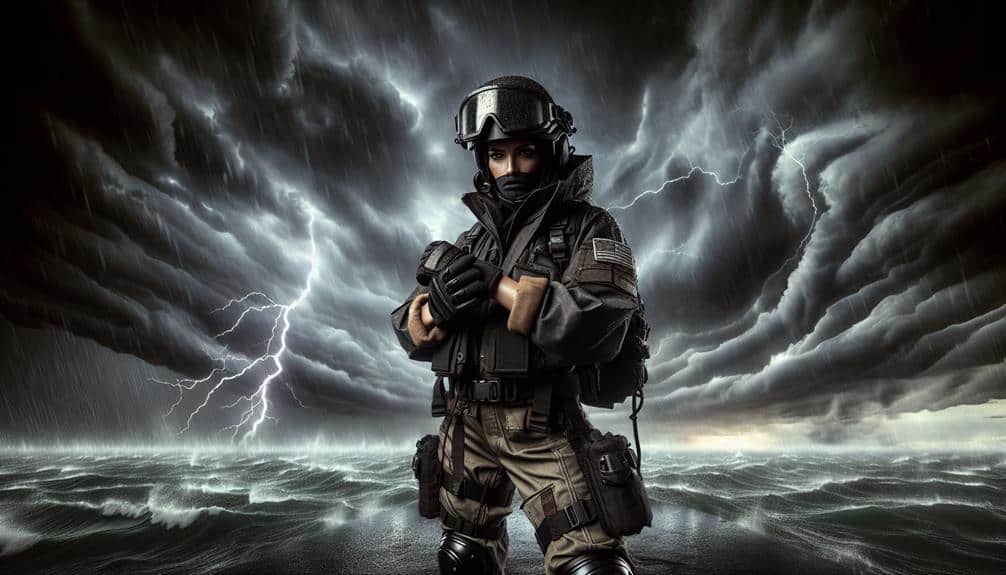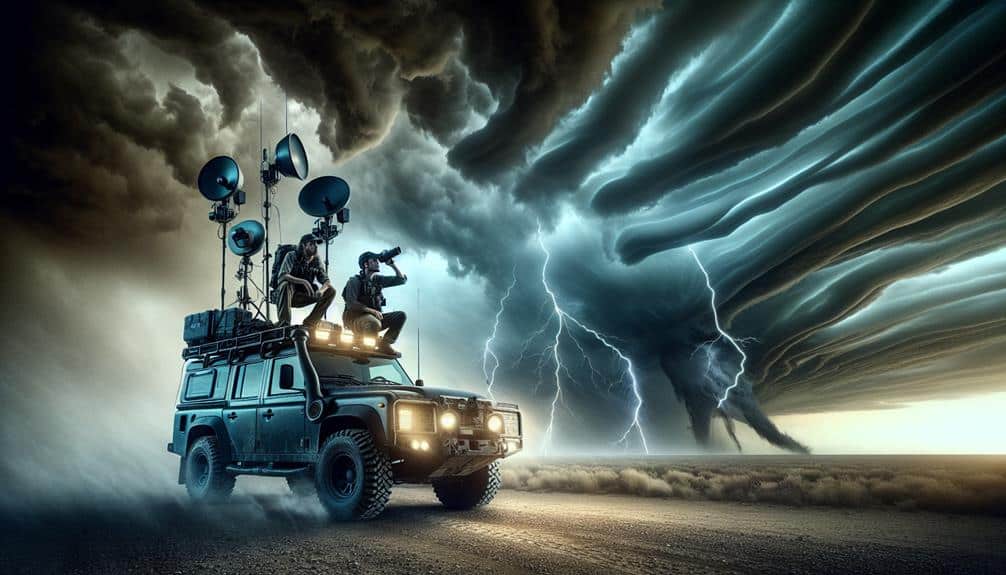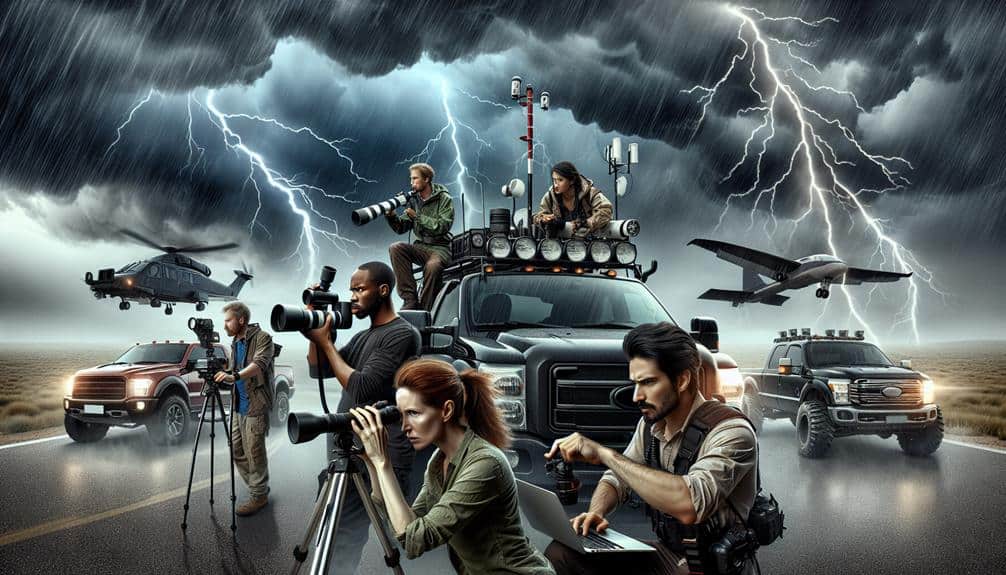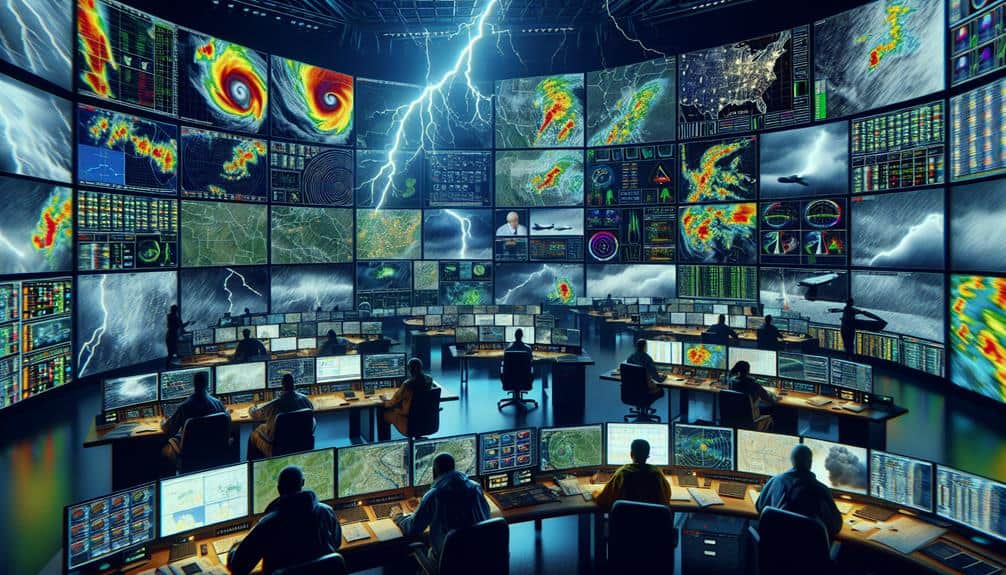We've reviewed and rated the top storm chaser gear to keep you prepared and safe in extreme weather. High-quality lightning detectors like StrikeAlert HD, which track strikes up to 40 miles away, and portable emergency shelters such as LifeSecure Emergency Shelter are necessary. Reliable weather radios with NOAA channels and built-in alert systems provide important updates. Durable cameras like the Olympus Tough TG-6 and wind-resistant tripods ensure clear footage. GPS units from Garmin, known for precision and durability, are essential. Protective clothing, including waterproof jackets and high-visibility vests, complete the gear. Explore further for our detailed evaluations and recommendations.
Key Points
- StrikeAlert HD lightning detector offers real-time data on strikes up to 40 miles away.
- LifeSecure Emergency Shelter is lightweight, portable, and withstands extreme weather conditions.
- Olympus Tough TG-6 camera is waterproof, shockproof, and captures 12-megapixel photos and 4K videos.
- Garmin Montana 700i GPS unit provides precise positioning and exceptional accuracy within a few meters.
Essential Storm Chaser Tools
When it comes to storm chasing, having the right tools is critical for both safety and data collection. We can't overstate the importance of lightning detectors. These devices provide real-time data on lightning strikes, helping us avoid dangerous zones. Modern lightning detectors are precise, offering range and strike intensity data, which can be critical in predicting storm movement.
For example, detectors like the StrikeAlert HD can detect strikes up to 40 miles away, giving us ample time to reposition or seek shelter.
Emergency shelters are non-negotiable. These portable units are designed to withstand extreme weather conditions, offering a refuge when the storm's fury becomes too intense. The most reliable models, such as the LifeSecure Emergency Shelter, are lightweight and easy to deploy, ensuring we can remain mobile without compromising safety. They're built to resist high winds and heavy rain, providing a secure environment to analyze storm data or simply wait out the worst conditions.
High-Quality Weather Radios
High-quality weather radios are essential for receiving real-time updates on severe weather conditions, ensuring we stay informed and can make timely decisions in the field. These devices are vital for our emergency communication strategy, delivering National Weather Service alerts and warnings directly to us. They're equipped with Specific Area Message Encoding (SAME) technology, allowing us to filter alerts by specific counties, enhancing our situational awareness and enabling precise, localized responses.
In storm chasing, every second counts, and weather radios that feature both AM/FM bands and NOAA channels provide the extensive coverage we need. Models with built-in alert systems automatically switch on during emergencies, ensuring we never miss critical information.
Battery life is a key consideration; we rely on radios with long-lasting power sources or backup battery options, safeguarding our operations even in prolonged power outages.
Safety precautions dictate that our gear must withstand harsh conditions. Top-rated weather radios are both water-resistant and impact-resistant, ensuring reliability in extreme environments. Advanced models also include USB charging ports, enabling us to charge devices, thereby maintaining our communication lines.
High-quality weather radios aren't just tools—they are our lifeline in the unpredictable world of storm chasing.
Durable Storm-Proof Cameras
Equipped with robust weather radios, we also need durable storm-proof cameras to capture high-resolution footage under extreme conditions, guaranteeing no moment of the storm goes undocumented. Our top choice is the Olympus Tough TG-6. This camera is waterproof up to 50 feet, shockproof from 7 feet, and freezeproof down to 14°F. With a 12-megapixel sensor and 4K video capabilities, it delivers exceptional image quality, even in the most challenging environments.
To stabilize our shots, we rely on wind-resistant tripods like the Gitzo Series 3. Its carbon-fiber construction ensures it can withstand gusts up to 40 mph, providing a steady base for our cameras.
Pairing this with waterproof binoculars such as the Nikon Monarch 7, we can scout distant storm features without worrying about equipment failure.
We also use the GoPro HERO10 Black for its compact design and ruggedness. It's waterproof up to 33 feet and captures 5.3K video at 60fps, perfect for high-action storm footage.
With these tools, we guarantee our documentation is as resilient as we are, allowing us to capture every critical moment with precision and clarity.
Reliable GPS Units
Moving through severe weather requires dependable GPS units that provide precise, real-time positioning and mapping data. For storm chasers, GPS accuracy is essential. We need units that accurately pinpoint our location, even in the most remote areas.
The Garmin Montana 700i stands out for its exceptional accuracy, often within a few meters, which is vital when navigating unpredictable weather patterns.
Battery life is another crucial factor. The Montana 700i offers up to 18 hours on a single charge, ensuring we stay connected during extended chases. For those needing even longer battery performance, the Garmin GPSMAP 66i, with up to 35 hours of battery life, is a reliable alternative.
A user-friendly interface is indispensable, allowing us to quickly interpret data without distraction. Devices like the Garmin eTrex 32x feature intuitive touchscreens and simple menu operation, enabling us to focus on the chase, not the device.
Durability can't be underestimated. Our gear must withstand harsh conditions. The Garmin inReach Explorer+ excels here, boasting a rugged design resistant to water, dust, and impact.
Combining these features—GPS accuracy, battery life, user-friendly interface, and durability—ensures our GPS units are reliable partners in the field.
Protective Clothing and Gear

Ensuring our safety during storm chases demands protective clothing and gear that can withstand extreme weather conditions and provide high visibility. The right gear isn't just about comfort—it's about survival and efficiency in the field.
We've analyzed various items based on durability, weather resistance, and practicality.
1. Waterproof Jackets
High-quality waterproof jackets are essential. They should offer excellent breathability and be lightweight. We recommend jackets with a minimum of 10,000mm waterproof rating to guarantee you stay dry even in torrential downpours. Features like taped seams and adjustable hoods enhance overall protection.
2. Sturdy Boots
Sturdy boots are essential for traversing rugged terrains and debris-strewn areas. Look for boots with reinforced toe caps and non-slip soles. A pair with Gore-Tex lining will ensure waterproofing while maintaining breathability. Ankle support and shock absorption are also crucial to prevent injuries.
3. High-Visibility Vests
High-visibility vests improve our safety by making us easily seen in low-light conditions. These should adhere to ANSI/ISEA 107 standards, featuring reflective strips and bright colors like neon yellow or orange. Lightweight and breathable materials will prevent overheating during extended wear.
Frequently Asked Questions
What Are the Best Apps for Tracking Storms in Real-Time?
We rely on the best radar apps like RadarScope and MyRadar for storm tracking. These apps provide high accuracy and real-time alerts, ensuring we're always informed and ready to act swiftly when severe weather approaches.
How Do You Prepare Your Vehicle for Storm Chasing?
Did you know that 75% of storm chasers report vehicle breakdowns? We guarantee vehicle maintenance and stormproofing, stock up on emergency supplies, and follow a detailed vehicle checklist to keep our chases safe and efficient.
What Safety Measures Should You Take While Storm Chasing?
When storm chasing, we prioritize safety precautions by equipping essential gear, establishing an emergency response plan, and adhering to a strict communication protocol. This guarantees we stay informed, connected, and prepared for any unforeseen dangers.
Can Drones Be Effectively Used for Storm Chasing?
Imagine a drone soaring through turbulent clouds. It is acknowledged that drones' limitations, but their effectiveness in storm chaser strategies is undeniable. They provide real-time data, though battery life and strong winds can hinder their overall utility.
Are There Any Storm Chaser Communities or Networks to Join?
We should absolutely consider joining communities and networking with fellow storm chasers. Finding support and resources within these networks can enhance our skills, provide crucial information, and guarantee we're better prepared for any storm chasing expedition.


